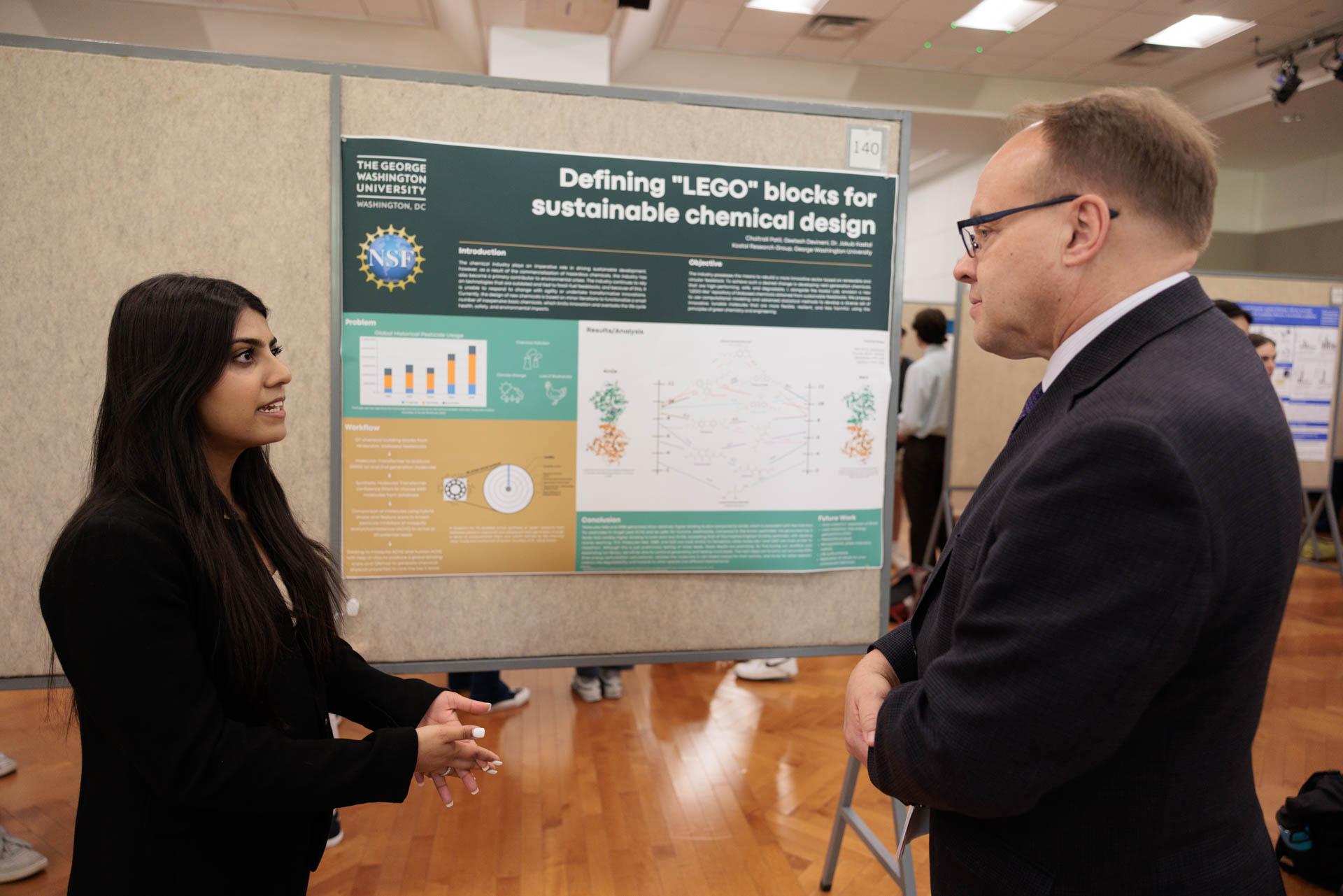Poster presentations of research projects by more than 125 undergraduate and graduate students from across the Columbian College of Arts and Sciences (CCAS) were on display at the inaugural CCAS Research Showcase on April 11 at the George Washington University Student Center.
The day-long event celebrated the range of research across the college with projects that represented more than 20 disciplines and were supported by over 100 faculty research mentors. Topics—many of them interdisciplinary—ranged from designing safer pesticides to exploring COVID-19 anxiety to understanding autism. More than 350 visitors were in attendance, including CCAS Dean Paul Wahlbeck and Vice Provost for Research Pamela Norris, along with faculty and fellow classmates.
“This work is a testament to the broad reach, depth and interdisciplinarity of what we do in our classrooms, labs and studio spaces,” Wahlbeck said. “These are students ready to join the next generation of scientists, scholars and artists who are equipped to meet the challenges ahead with fresh and innovative ideas.”
Evangeline J. Downie, CCAS associate dean of research and strategic initiatives and professor of physics, said she was “grateful that the GW community came out in force in support of our students.”
“It was fantastic to see how engaged the students and their research mentors were and the depth of expertise and ownership of their research projects,” she said.
For students, the showcase represented the culmination of months—even years—of data collection and analysis. Hope Ledford, a senior political science major, began investigating her project on the impact of small-dollar contributions to political candidates of color after interning with a Washington, D.C., advocacy group two years ago. That experience sparked her passion to address the intersection of money and politics—a topic she will continue studying as she pursues her master’s in public policy at GW after graduation. “I’m interested in finding data-driven solutions to reforming the democratic space and make our democracy more accessible for more people,” she said.
As a second-year master’s student in art therapy, Brianna Issenberg spent nearly a year helping an 84-year-old woman with Alzheimer’s-related dementia regain control over her daily life. “For a lot of people with dementia, their autonomy is lost because they are in need of constant care,” she said. In her project, she described how art therapy helped the woman make decisions about her creative pieces, often using them to work through past trauma. “My study focuses on artmaking as a mean of self-exploration,” Issenberg explained. “Through art, she was able to open herself up and discover herself again.”
Other students discussed their personal connection to their projects. Senior Grace Bradley was spurred by her own classes in Corcoran Hall to track airflow in on-campus spaces. Working with Professor of Physics Mark Reeves, she investigated the aerosol particles in humid classrooms. “I wanted to look at the measures we can take to decrease the amount of stagnation in those spaces and help protect all of us against airborne illness transmission,” she said.
Adewale Maye, a second-year economics master’s student, studied the impact of flooding on food security in Southern Nigeria—including on his own extended family who live in the region. Maye hopes his research can be used to improve the country’s water management infrastructure and flood mitigation programs. “My major is applied economics so I think it’s really important that the tools I’m learning apply to real world issues,” he said. “That’s the motivation for all my work—and I think it’s the motivation for a lot of people here today too.”
In fact, many students noted that, in addition to presenting their own research, the highlight of the event was comparing research notes with classmates from different disciplines. Senior biology major Reem Bahr, for example, discussed her Luther Rice Fellowship project on using mice to measure human postnatal adversity with her showcase neighbor Claire Lanthier, a senior who presented an American studies examination of gentrification among Washington, D.C.’s historically Black churches.
The event “shows how much in-depth student research is happening in so many different disciplines,” said Chaitrali Patil, a junior biology and statistics major who worked with Assistant Professor of Chemistry Jakub Kostal on designing safer pesticides. “Just walking around here, I saw projects on the humanities and the arts—things I don’t often get to see as a STEM student.”
“Having students and faculty engage with each other over all these different topics makes this a special event,” added criminal justice major Kate Hafemeister who worked with Professor of Clinical Psychology Sharon Lambert to trace neighborhood perceptions of community violence and their links to adolescent behavior. “We can all be inspired by the breadth of research around us.”




